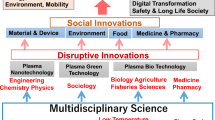Abstract
Plasma and ion-beam surface treatments by energetic particle bombardment enable a high degree of freedom and control of surface material chemistry and microstructure. The development of plasma and ion-beam surface modification methods and tools has allowed the synthesis, modification and exploration of new technologically important materials. Plasma surface treatments together with low energy (< 5 keV) ion-beam processing of surfaces, thin films, and nanostructures result in new phases and metastable states that directly impact the chemical, physical, and morphological properties of the material. Thus, this field is highly relevant for new applications such as tribological, optical and biomedical coated surfaces.
Similar content being viewed by others
Avoid common mistakes on your manuscript.
Introduction
Plasma and ion-beam surface treatments by energetic particle bombardment enable a high degree of freedom and control of surface material chemistry and microstructure. The development of plasma and ion-beam surface modification methods and tools has allowed the synthesis, modification and exploration of new technologically important materials. Plasma surface treatments together with low energy (< 5 keV) ion-beam processing of surfaces, thin films, and nanostructures result in new phases and metastable states that directly impact the chemical, physical, and morphological properties of the material. Thus, this field is highly relevant for new applications such as tribological, optical and biomedical coated surfaces.
Depending on the particle energy and type (neutrals, positive or negative ions), energetic particle bombardment can determine thin film structure and properties by:
-
condensing metastable phases, forming strong material bonds, and creating smooth surfaces
-
limiting mechanical stress that often leads to delamination of the layers
-
growing generally dense films at reduced deposition temperature with the ability to tune film porosity, optical, electronic, and mechanical properties.
For example, one can affect the refractive index and mechanical stress in the case of the optical coatings, and the free electron mobility in the case of the transparent conductive oxides (TCO), influenced by the formation of defects which may trap and scatter free electrons.
The variety of thin film deposition methods utilizes plasma assistance to achieve a desired combination of functionalities. The most established techniques include magnetron sputtering (MS), plasma enhanced chemical vapor deposition (PECVD), pulsed laser deposition (PLD), and filtered or unfiltered cathodic vacuum arc deposition (CVAD). The flexibility of many of those processes may be further increased by applying pulsing.
To analyze film deposition involving energetic particles one has to consider both particle fluxes to and from the substrate. Particle-induced desorption as well as physical and chemical sputtering during growth can have a great influence on the film growth rate, microstructure, and texture formation. Since many of the arriving particles are ions, the substrate is highly biased (e.g. hundreds of volts) which can increase the sputter yield to a point where ion etching dominates over film deposition. However, ion etching can be utilized for surface pretreatment prior to film deposition.
In the last decades, thin film technologies have evolved significantly, supported by novel models describing the emission, transport and condensation of the particles in various conditions. These models allow us to explore (new) microstructural configurations. In a complementary manner, reactive and combinatorial syntheses are increasingly applied to grow chemically complex layers with good control over the composition. With these tools in hand it is becoming possible to set specific bonding states and electronic structures for fundamental studies and specific applications.
Today, the recent trend in magnetron sputtering is to apply very high power in short pulses at a low duty cycle, but at an average power comparable to the normal direct-current operation. For example, if the duty cycle is only 0.01, the instantaneous pulse power can be increased by a factor of 100. The main advantage is the creation of a dense plasma with a high concentration of target element ions, rather than sputter gas and target atoms as in conventional sputtering. This style of sputtering is called High Power Impulse Magnetron Sputtering (HiPIMS) or High Power Pulsed Magnetron Sputtering (HPPMS). The availability of vast amounts of ions makes it possible to affect and control the coating properties. Some examples are sputter-cleaning of the substrate for enhanced adhesion, increased coating density both in elemental as well as compound coatings, and control of the material texture and microstructure. For instance, TiN and rutile TiO2 have been synthesized at room-temperature. However, to best utilize the possibilities offered by the target material ions, the substrate bias must be optimized for each application. Hence, considerable effort is spent in academia as well as in industry to better understand the relationship between the flux of ions and neutrals to the substrate and film qualities like stress, composition and structure. Unfortunately, HiPIMS typically provides a much lower average rate of deposition per average power compared to conventional sputtering. This is very pronounced for metal coatings, whereas for some oxides the opposite has been reported. Another potential problem is the higher kinetic energy of the sputtered particles, which may make some structurally sensitive materials difficult to synthesize. Continued research and development will aim at understanding and rectifying these two challenges in HiPIMS.
This Focus Issue considers new developments in this and similar fields and provides an overview of the types and energy distributions of ions in certain types of plasma processes and their consequences for film properties. The papers selected for the Focus Issue address both advantageous and detrimental aspects of ion bombardment in plasma-based processing. We would like to thank all the contributors and reviewers as well as all the JMR personnel who helped us achieve a successful JMR Focus Issue.
Author information
Authors and Affiliations
Rights and permissions
About this article
Cite this article
Endrino, J., Anders, A., Andersson, J. et al. Plasma and Ion-Beam Assisted Materials Processing. Journal of Materials Research 27, 741–742 (2012). https://doi.org/10.1557/jmr.2012.53
Published:
Issue Date:
DOI: https://doi.org/10.1557/jmr.2012.53




